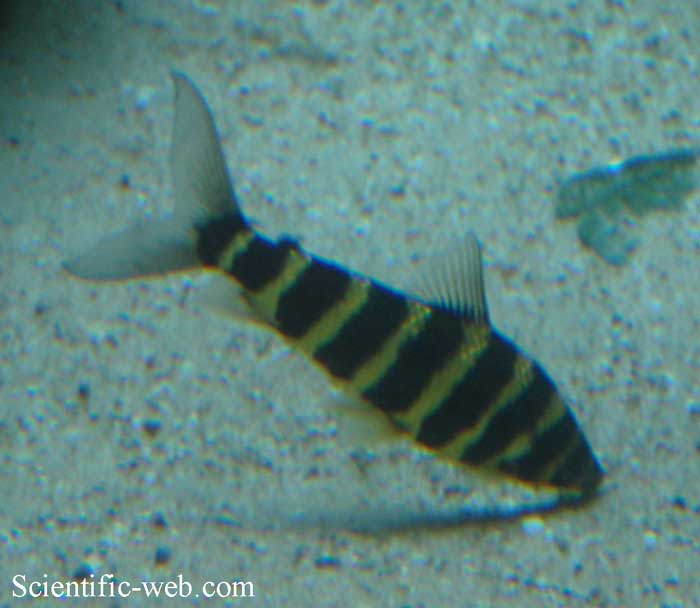
Leporinus fasciatus, Photo: Michael Lahanas
Superregnum : Eukaryota
Cladus: Unikonta
Cladus: Opisthokonta
Cladus: Holozoa
Regnum: Animalia
Subregnum: Eumetazoa
Cladus: Bilateria
Cladus: Nephrozoa
Superphylum: Deuterostomia
Phylum: Chordata
Subphylum: Vertebrata
Infraphylum: Gnathostomata
Megaclassis: Osteichthyes
Superclassis/Classis: Actinopterygii
Classis/Subclassis: Actinopteri
Subclassis/Infraclassis: Neopterygii
Infraclassis: Teleostei
Megacohors: Osteoglossocephalai
Supercohors: Clupeocephala
Cohors: Otomorpha
Subcohors: Ostariophysi
Sectio: Otophysa
Ordo: Characiformes
Superfamilia: Anostomoidea
Familia: Anostomidae
Genus: Leporinus
Species: Leporinus fasciatus
Name
Leporinus fasciatus (Bloch, 1794)
References
Leporinus fasciatus – Taxon details on Integrated Taxonomic Information System (ITIS).
Vernacular names
English: Banded leporinus, Black-banded leporinus
português: Piau-flamengo
ไทย: ปลาดินสอ, ปลาปล้องอ้อย
Leporinus fasciatus, commonly known as the banded leporinus[2] or the black-banded leporinus,[3] is a species of characin in the family Anostomidae. L. fasciatus is native to the Amazon Basin in South America, but has been introduced into the US states of Florida and Hawaii.[4] It has not been observed from Hawaii as of 2005; the species is thought to have been extirpated in the region.[2]
Leporinus fasciatus has been recorded to reach 30 centimetres (12 in) in length, although individuals reach maturity around 15 centimetres (5.9 in).[5] L. fasciatus is yellow with black stripes, frequently also exhibiting orange markings on the head and tail fin.[6] There is some variation in colouration, with a bright yellow or beige body and transparent fins.[1] There are eight to twelve vertical bands on the body.[7] Females may be distinguished from males in that adult females are larger.[1] L. fasciatus is omnivorous: its diet comprises vegetative matter as well as other fish, worms, and crustaceans.[5]
Leporinus fasciatus is tropical freshwater species, native to the rivers and flooded forests of South America. Its range encompasses the Amazon Basin.[5] L. fasciatus has also been recorded in the US states of Florida and Hawaii, probably introduced accidentally as a result of aquarium releases. However, it has not been reported from Hawaii for several years; therefore the Hawaii population is thought to have been extirpated.[2] It is generally found in fast-flowing waters.[5]
L. fasciatus plays a minor role in fisheries. Its main importance to humans is in the aquarium trade.[5] L. fasciatus may jump if startled, necessitating aquariums with strong tops.[1] In captivity, L. fasciatus can eat algae, vegetative matter, and flake food in addition to the worms, insects, and crustaceans it would catch in the wild. It can be kept with other fish, and has been described as "hardy".[1]
References
Fishes portal
Butler, Rhett. "Black-banded Leporinus, Banded Leporinus". MongaBay. Retrieved 16 November 2010.
Nico, Leo; Pamela J. Schofield. "Leporinus fasciatus (Bloch)". Nonindigenous Aquatic Species. US Geological Survey. Retrieved 13 November 2010.
"Leporinus fasciatus". Integrated Taxonomic Information System. Retrieved 13 November 2010.
Reis, Roberto E; Sven O. Kullander; Carl J. Ferraris (2003). Check list of the freshwater fishes of South and Central America. EDIPUCRS. ISBN 85-7430-361-5.
Froese, Rainer; Pauly, Daniel (eds.) (2010). "Leporinus fasciatus" in FishBase. September 2010 version.
Goulding, Michael (1980). The fishes and the forest. University of California Press. ISBN 978-0-520-04131-8.
Birindelli, José L. O.; Heraldo A. Britski (2009). "New species of the genus Leporinus Agassiz (Characiformes: Anostomidae) from the rio Curuá, rio Xingu basin, Serra do Cachimbo, Brazil, with comments on Leporinus reticulatus". Neotropical Ichthyology. São Paulo. 7 (1): 1–9. doi:10.1590/S1679-62252009000100001. ISSN 1679-6225.
Retrieved from "http://en.wikipedia.org/"
All text is available under the terms of the GNU Free Documentation License


